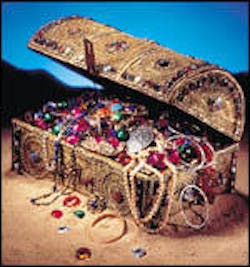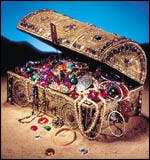More Gems of wisdom
by Kenneth Koch, DMD, and Dennis Brave, DDS
The "Real World" guys offer more tips on getting the most benefit from rotary files.
We have a variety of "gems" to offer on rotary file technique. The first is to always have a secure finger rest. This is somewhat analogous to establishing a finger rest when scaling. With the proper finger rest, you can prevent yourself from getting sucked into the canal. This applies particularly to those cases where you are using large taper files (.06 and greater).
However, if you get "sucked down" into a canal and hear a click, what do you do? Keep the engine running and back the file out of the canal. Inspect the file. Is it 21 mm or 19 1/2 mm? Assume the file is 21 mm. Examine it for any "shiny spots." If a shiny spot exists, trash the file. If the file does not have a shiny spot (not unwound), we can use it again. Proceed cautiously, however; something within the canal obviously stressed it.
However, if you get "sucked down" into a canal and hear a click, what do you do? Keep the engine running and back the file out of the canal. Inspect the file. Is it 21 mm or 19 1/2 mm? Assume the file is 21 mm. Examine it for any "shiny spots." If a shiny spot exists, trash the file. If the file does not have a shiny spot (not unwound), we can use it again. Proceed cautiously, however; something within the canal obviously stressed it.
Another "gem" we advocate to prevent separation and "suck down" is to keep the file moving. While some techniques do not advocate this, we have found that keeping the file in continuous motion is clinically very important. If you do not keep the file moving, there can be a tendency to lose some proprioceptive control. As a result, you might get pulled into the canal like a wood screw. This is very important to avoid, particularly in the apical 2-3 millimeters. Do not make grand flourishes with the instrument; keep it moving in a controlled fashion.
The real "quantum leap" in endodontics was moving from hand files to a rotary technique with air turbines. Then came electric engines, followed by torque-control electric engines. The whole purpose of torque-control is safety. The advantage of a torque control engine is that when a file is stressed beyond a certain preset limit, it will automatically reverse and, in certain cases, back itself out of the canal. This is a decided safety factor and is very helpful for the beginning practitioner. Torque control engines will continue to evolve to the point where the engines can recognize the various files when placed in the contra angle.
In addition to torque-control engines, it is very important to run the files at the proper RPM. Do not run the files at too low a speed. The reduced speed gives a sensation of not cutting; consequently, the clinician leans on the files.
Possibly the most common cause of separation is failing to understand the anatomy of the tooth requiring treatment. Let's look at some examples. The tooth that causes the most problems is the lower first molar. This is because the two mesial canals are oftened joined. Generally, the ML joins the MB, although it can be the opposite. Before you do a lower molar, you must determine whether or not the two canals come together. We can determine this by either of two methods. First, take an angled pre-op X-ray, then move the conehead 15 or 20 degrees, either mesially or to the distal. Very often this will separate the roots and you can see whether the canals join.
The second technique is the time-honored K-file trick. Take a K-file and place it to length in the MB canal. Let's assume it extends 21 mm. Now, take another K-file and place it in the lingual canal all the way to the end. Assume that it extends 18 mm. Remove the K-file from the buccal canal. If the K-file in the lingual canal now extends to 21mm, you have confirmed that the two canals come together.
If the two canals combine you have three ways of treating the situation. One option is take a rotary file to length in the MB canal, proceeding no further than the point at which the canals join. If you do, you risk getting "sucked down" the canal and separating an instrument. The other way to treat this dilemma is to take the rotaries down both canals, but only to the point where they meet. You then finish the last 3 mm in the buccal canal with a hand file. Either way will work, but, with experience, you will prefer the former method.
Another option also exists. You can instrument both canals simultaneously. This option is a little more tricky, but equally effective.
Another challenge is a root with a sharp hook. A 90-degree hook is quite common on distal roots of lower molars. How can we treat this anatomy without breakage? Nickel titanium is an alloy that does fabulously well in big "banana" curves (such as the MB root of maxillary molars), but does not do particularly well when stressed 90 degrees. The alloy fatigues rapidly in these cases.
The "gem" is in how to treat this 90-degree headache. Take a rotary file down the canal and stop just short of the curve. Then, take a stainless steel hand file — not nickel titanium — and "J-hook" it. This means creating a 90-degree bend at the end of the file. Take the J-hook file down the canal, and it will stop just short of the hook.
Proceed to watch-wind the file; the hooked file goes around and around and eventually slides into the curve. Once it enters the curve, really work it. It is traditionally very difficult to enlarge much more than a size 20, but at least the canal is clean. You can now fill the hook with thermoplastic gutta percha, and you haven't broken anything.
The third anatomical challenge is the S-shape canal. We usually see this formation with maxillary premolars. When you instrument a double-back canal, take the rotaries down and stop after the first curve. Proceed to the last 2-3 mm with a hand file. This will be quite easy because you have done a crown-down preparation. With experience — the key — you will be able to completely instrument an S-shape canal with a rotary file, without breaking the file or straightening the canal.
A final challenge is the almond-shape canal. The basic problem with this shape is that rotary files are round and many canals are not. In these situations, do not work a landed rotary file in an anticurvature fashion, such as we use with a hedstrom file. Most rotaries are not designed to work in this manner. Use the rotary as intended and, if there are tissue tags along the walls as a result of the almond shape, use a hedstrom hand file to remove them. It requires only a few seconds and results in a very clean canal. Never force or push rotary files in a lateral motion.
Operatory management
Most clinicians wish to use rotary files more than once. Therefore, some final "gems" are in order concerning sterilization and file management. Do not use salt/bead sterilizers. These units are too hot and will fatigue the files. Avoid this "sterilization" technique.
Place the rotary files in an ultrasonic (up to three minutes) before sterilization. It is important to keep the NiTi rotary files separate from the stainless steel files and instruments. If the stainless steel comes in contact with the nickel titanium, the result will be detrimental to the NiTi file. A small glass beaker to hold the NiTi files in the ultrasonic unit will work very nicely.
We really like the "statem" for sterilization of rotary files. The cycle is short and the flat cartridge is convenient. Avoid using the long-cycle autoclaves for your rotaries. Even though academic studies show there is no difference, it seems that after repeated (more than five) sterilizations, the rotary files loose some of their "flexibility." This is the observation of two guys who have done a lot of rotary cases. If you sterilize your files more than five times, you should discard them.
To monitor the number of times a file has been used, you can use autoclavable sponges and mark the sponge accordingly. You can also use gauze pads to hold files, but make certain the assistant marks the tape. The wrap needs to be sufficiently flat to fit into the "statem." The more times you use a file, however, the more likely you are to have a separation incident.
If you absolutely want a number for "how many times can I use a file," the answer is probably about six canals per file. However, there are so many variables that we do not like to state a number. It's not how many times the file was used, but rather, how the file was used. For example, a calcified canal stresses a rotary file far more than a vital tooth in a young patient.
We have given you a number of "gems" to prevent separation. If you have not already attended a hands-on rotary course, we strongly recommend it. The information that you will gain from such a course, combined with our "Real World Gems," will make endodontics easier, faster, and, most importantly, better!

